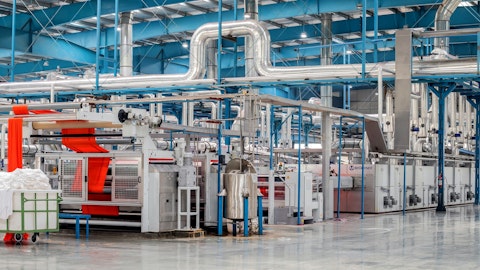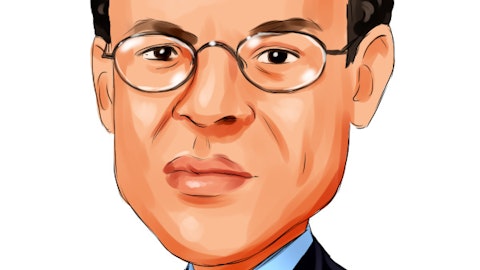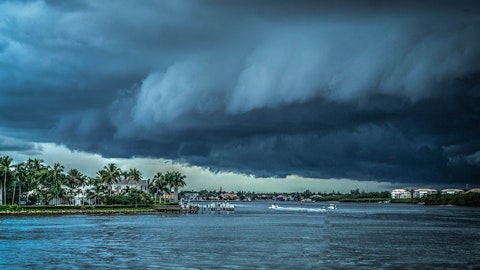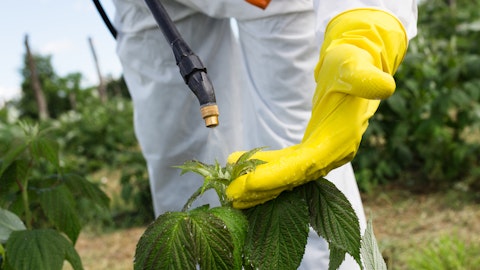Lakeland Industries, Inc. (NASDAQ:LAKE) Q3 2024 Earnings Call Transcript December 7, 2023
Operator: Good day, and welcome to the Lakeland Industries Fiscal 2024 Third Quarter Financial Results Conference Call. [Operator Instructions]. During today’s call, we will make statements relating to our goals and objectives for future operations, financial and business trends, business prospects and management’s expectations for future performance that constitute forward-looking statements under federal securities laws. Any such forward-looking statements reflect management’s expectations based upon currently available information and are not guarantees of future performance and involve certain risks and uncertainties that are more fully described in our SEC filings. Our actual results, performance or achievements may differ materially from those expressed in or implied by such forward-looking statements.
We undertake no obligation to update or revise any forward-looking statements to reflect events or developments after the date of this call. During today’s call, we will discuss financial measures derived from our financial statements that are not determined in accordance with U.S. GAAP, including adjusted EBITDA and adjusted EBITDA margin. A reconciliation of each of the non-GAAP measures discussed on this call to the most directly comparable GAAP measure is presented in our earnings release. At this time, I would like to introduce you to your host for this call, Lakeland Industries’ Executive Chairman, Jim Jenkins, Mr. Jenkins, the floor is yours.
Jim Jenkins : Thank you, operator. Good morning, and thank you all for joining us for our third quarter fiscal 2024 earnings call. I would like to begin today’s call by thanking and celebrating our Lakeland team members across the company with our commitment to delivering our strategic initiatives during the quarter. These efforts have helped drive revenue growth in key strategic markets, execute a continued shift in our revenue profile towards higher-value products and carry out our small, strategic and quick, or SSQ, acquisition strategy. As we enter the next chapter for Lakeland, I know I can speak for myself, our executive team and the Board when I say that we are excited about the company’s future supported by the strength and depth of our organization and leadership teams.
Before turning to our third quarter results, I’d like to provide a brief update on our ongoing CEO search. The Board is following a very thorough vetting and selection process and engaging executive recruiter has preliminarily identified a few candidates. We’re eager to find the right leader, but we will be methodical and deliberate as we seek a candidate who will continue to drive our business strategy and culture. Lakeland has a solid foundation in place with an exciting runway for growth, and the Board and I look forward to sharing more with you as the search process evolves. Now shifting gears to the quarter. Our first third quarter results — our fiscal third quarter results were very positive. And as we continue to see demand accelerate and growth within our key product lines and markets, Lakeland delivered net sales of $31.7 million, up 11.6% year-over-year.
Notably, many of our high-value strategic product lines saw growth in the quarter, including fire service and industrial products categories. Our fire service business continues to expand, driven by our superior lead times versus our competitors, innovative designs from the Eagle team and onboarding successes with new distributors. As expected, we also continue to see strong demand from oil and gas turnaround activity, which, as we discussed in previous quarters, is having extended season in 2023. Finally, we saw a significant increase in our direct-to-customer container business, which is a strategic focus for us. This growth highlights the significant momentum Lakeland is building in our high-value product lines, and our goal to increase penetration in high-value markets is producing positive results.
We believe our recently announced Pacific Helmets acquisition will further enhance our fire service growth. In terms of profitability, our third quarter gross margins remained strong at 42.2%. And importantly, our adjusted EBITDA grew by over $300,000 or 10.8% to $3.3 million in the quarter, even with the negative impact of foreign exchange in the quarter, which Roger will discuss later. This resulted in an adjusted EBITDA margin of 10.4% compared to 10.4% last year. Adjusted for the impact of negative FX in the quarter, our adjusted EBITDA would have been approximately 14.2%. With regard to our geographic markets, we continue to see strong demand trends in North America, particularly in the U.S. and Latin America as well as our EMEA markets to a lesser extent.
We also were encouraged to see increases in our India and Australia markets for the quarter as these are potential growth markets for us. In North America, our sales teams continue to have success adding new distributors and expanding our commercial reach. Additionally, our considerably shorter manufacturing lead times as compared to many of our competitors have resulted in Lakeland gaining traction as a preferred supplier in our fire service and industrial categories. As we have discussed in past calls, we continue to see our strategically located manufacturing as a competitive advantage in enabling our favorable lead times. Finally, our Latin American business continued its exceptionally strong performance for the year as we are the market leader in several of the markets served.
As has been the case for the first half of the year, our Asian markets continued to perform below expectations as a result of ongoing macroeconomic weakness and overhang of PPE equipment from China’s COVID-19 lockdown. As a result, we expect our Asia Pacific business to remain below our initial projections over the last quarter of the year. Shifting gears a bit, I’d like to spend a few minutes discussing the company’s small, strategic and quick M&A strategy and our overall commitment to identifying and maintaining a robust acquisition pipeline with opportunities that enhance Lakeland’s high-value product portfolio. Last week, we were pleased to announce the acquisition of Pacific Helmets. Pacific is a highly regarded global brand with a well-established reputation for quality and innovative design and manufacturing and the growing first responder safety helmet market.
The company has a broad range of helmet models, styles and certifications and they have demonstrated the ability to develop new products and sell successfully around the world. The acquisition of Pacific is a significant milestone in our efforts to build Lakeland as a premier global fire brand as it enhances our product portfolio and strengthens our ability to deliver exceptional fire turnout protection offerings to our customers worldwide. Pacific has one of the largest ranges of helmets — helmet model, styles and certifications of any international helmet manufacturer. The company currently produces 26-plus helmet models and has a significant number of new product innovations launching in the near future. Like Lakeland, Pacific owns its own manufacturing facilities and has an in-house R&D team that enables it to customize and produce helmets specified to the customers’ specific requirements more easily.
Pacific Helmet currently has a strong revenue and tender pipeline and global demand for safety helmets is growing. They already sell into over 40 countries, and we believe the business is further scalable through the addition of new distributors, particularly in the Northern Hemisphere and emerging markets, in which Lakeland already has a strong presence. We expect this acquisition to be immediately accretive to Lakeland’s bottom line results and are excited about the organic and cross-selling opportunities going forward. I’m excited to see our global sales team execute on this opportunity, and we look forward to sharing more about the integration of the Pacific business in the Lakeland platform in the future. I’d also like to welcome the Pacific team to the Lakeland’s family, and we’re very excited to have you as part of our team and the potential for the future.
I also want to thank our team here at Lakeland for all their hard work recently in closing this deal. We continue to be very pleased with the performance of our Eagle acquisition, and we believe Eagle is an excellent template for our SSQ acquisition model. After delivering a large tender during Q2 of this year, we expect Eagle to ship another larger order in Q4. Additionally, we are continuing efforts to integrate Eagle products into Lakeland’s geographic markets as well as to accelerate the sales of Eagle gloves in particular block and hoods. Eagle’s fired gloves and particle blocking hoods are progressing through the certification process, and Lakeland has leveraged Eagle’s in-house designers in the development of our next-generation NFPA turnout gear, which is currently underway.
As we look to the balance of the fiscal year and beyond, I am confident in and impressed by our current management team. I’m also encouraged by the exciting runway for growth this company has. Lakeland is focused on solidifying our foundational business and investing our resources in high-growth geographies, which will include product line enhancements and the optimization of our operating and sales channels. Over the longer term, we are committed to building out a premier global fire brand, as I previously mentioned. This will include the release of new and innovative products, additions to our global sales force and a renewed marketing focus, all of these efforts will benefit from the addition of Pacific to our existing platform. Finally, Lakeland is committed to expanding our products and capabilities through our small strategic and quick acquisition strategy.

Continued M&A will help Lakeland’s already diverse line of products, bring premier global brands on to the Lakeland platform and drive strong operating leverage through cross-selling on Lakeland’s vast distribution and sales network. I’ll now pass the call to Roger to provide an overview of our financial results. Roger?
Roger Shannon : Thank you, Jim, and hello, everyone. Before I get started with my comments on the financials, I’d like to remind everyone listening that we have posted investor slides that align with the information I’ll present on our website at www.lakeland.com. Lakeland delivered sales of $31.7 million in the third quarter ended October 31, 2023. Domestic sales were $15.1 million or 47.6% of total revenues and international sales were $16.6 million or 52.4% of total revenues. This compares with domestic sales of $14 million or 49.3% of the total and international sales of $14.4 million or 50.7% of the total in the third quarter of fiscal ’23. As we noted in our earnings press release issued yesterday afternoon, we delivered strong year-over-year sales growth and continued strong profitability.
In terms of product mix for the quarter, our fire service category continues to increase as a percentage of Lakeland sales and represented 18% of the total revenue for the quarter compared to 12.5% in the year ago period. Disposables continue to decrease as a percentage of Lakeland sales and represented 38% of total revenues compared to 50% in the year ago period. This reflects the efforts we’ve made to shift our product mix towards higher value, higher margin and less commoditized products, as we have discussed in prior calls, as well as continued weakness for this product line in Asia. For the fiscal year-to-date, our fire service business is 21.4% of sales and disposables are 39%. From a segment reporting standpoint, Lakeland saw strong sales growth in our U.S., European, Canadian and Latin American markets.
This growth was partially offset by softer Asian sales, particularly in China, which is a continuation of what we’ve seen over the last few quarters. For the current quarter, sales in the U.S. were $15.1 million or 48% of total revenue, an increase of $1.1 million over the year ago period. Latin American sales grew $1.6 million to $4.2 million in the current quarter, an increase of 63% over Q3 of last year. All geographic regions except for Asia showed increases over the year ago period. Due to the inherent timing variability in our fire service business as a result of the timing of deliveries on large tenders, we have begun more closely tracking our trailing 12-month, or TTM, revenue. For the 12 months ended October 31, 2023, our TTM revenue was $122.4 million, an increase of $11.8 million or 11% over the trailing 12 months ended October 31, 2022.
Gross profit for Q3 of this quarter was $13.4 million, an increase of $1.1 million or 9% over the year ago period. Gross profit as a percentage of net sales was 42.2% for the fiscal 2024 Q4, as compared to 43.3% a year ago. Gross profit performance in the current period was driven by increased revenue during the quarter, including sales of previously reserved excess inventory, partially offset by an adjustment for intercompany profit in ending inventory. Our gross margin percentage was affected by an adjustment for intercompany profit and ending inventory and amortization of previous year adjustments to excess inventory, partially offset by improved product mix, lower freight cost, manufacturing cost improvements and the reduction of total inventory, including fully and partially reserved inventory.
Lakeland reported operating profit of $3.6 million in Q3 of ’24 as compared to $2.1 million in the third quarter of last year. As a result, operating margins were 11.4% in the third quarter, up from 7.6% in the third quarter of last year. Our operating profit benefited from increases in sales and lower operating expenses during the third quarter. The company evaluated the earn-out consideration accrual related to the Eagle acquisition and reduced this accrual by $1.5 million, which was recorded as a reduction in operating expense in the quarter. This decrease was offset by increases in currency fluctuations of $700,000, primarily related to the Argentine peso. Additionally, higher related — higher sales-related costs, including increases in travel and trade show expenses, were realized as we continue to invest in growth initiatives across the company.
Lakeland delivered net income of $2.6 million or $0.35 per basic share and $0.34 per diluted share during the quarter. This compares to net income of $1.4 million or $0.19 per basic and diluted share in the prior year period. Adjusted EBITDA was $3.3 million in Q3 ’24, an increase of 10.8% compared to $3 million in Q3 of ’23. Adjusted EBITDA performance in the quarter was driven by higher sales, partially offset by the impact of the previously mentioned negative FX impacts in operating expenses. Our adjusted EBITDA margin for Q3 of fiscal 2024 was 10.4% compared to the same number in the year ago period. Adjusted for the impact of negative FX in the quarter, our adjusted EBITDA would have been approximately 14.2% in the current quarter. On a trailing 12-month basis, Lakeland’s adjusted EBITDA of $12.1 million is an increase of 21.2% versus the TTM adjusted EBITDA of $9.9 million as of October 31, 2022.
Now turning to the balance sheet. Lakeland ended the quarter with cash and cash equivalents of approximately $26.4 million, an increase of $1.8 million compared to our prior year-end cash balance of $24.6 million. Lakeland delivered cash flow from operations during the quarter of $3.8 million, driven by profitable operations and a $2.6 million reduction of raw materials and finished goods inventory. Year-to-date, we have produced positive operating cash flow of $7.7 million, led by profitable operations and a $3.2 million decrease in inventory. Offsetting the operating cash flows were $3 million in investing activities split between capital equipment and additional investment in body track. Financing activities for the fiscal year-to-date, primarily quarterly dividends, U.K. bank repayments and treasury stock purchases totaled $1.8 million.
Finally, cash balances have been impacted by $1.1 million during the year-to-date due to currency fluctuations, primarily from the Chinese yuan and Argentine peso. The company continued to have no debt at the end of the quarter and has up to $25 million available from bank credit facilities. Capital expenditures for the 3 months at October 31, 2023, were $400,000 and $1.5 million year-to-date. As a reminder, we now expect CapEx to be approximately $2 million for the full fiscal year as we replace existing equipment in the normal course of operations. The Monterrey expansion, which we discussed last quarter, remains on pause as we continue to assess weather-related damage to our leased building. Inventories declined $3 million quarter-over-quarter to $54.4 million from $57.4 million at the end of the second quarter of fiscal ’24.
We were pleased to see the acceleration of inventory reduction in the quarter, and this remains a top operating objective. During the quarter, we utilized various sales and marketing programs as well as price deviations on reserved inventory to assist this effort, and we will continue to do so moving forward. In closing, I’d like to briefly discuss 2 transactions that occurred subsequent to quarter end and their impact on Lakeland’s financial profile. First is the acquisition of New Zealand-based Pacific Helmets for $8.5 million, subject to post-closing adjustments and customary holdback provisions, which Jim already covered in detail. The transaction was funded through the company’s revolving credit facility and cash balances. We expect Pacific to add $7 million to $8 million of sales revenue to Lakeland in our next fiscal year and for the company to be immediately accretive to Lakeland’s bottom line results.
Next is the sale of the company’s Brantford, Ontario warehouse. On November 27 of 2023, the company sold its office and warehouse facility in Brantford, Ontario to an unrelated party for $4.9 million. This sale will result in a pretax gain after selling expenses approximately $3.8 million that will be recognized in the fourth quarter of this year. Going forward, the company will utilize third-party logistics providers for customer fulfillment in Canada. Finally, on November 30, 2023, we entered into Amendment number 3 to the loan agreement with Bank of America. In this third amendment, the lender consented to our acquisition of the equity interest of Pacific and to permit additional indebtedness to be made available on Pacific by its existing bank relationships.
The amendment also waived Lakeland’s borrowing base limitations through January 31, 2024. With that overview, I’d now like to turn the call over to the operator to open the call up for questions.
See also Top 20 Most Valuable American Companies Today and Dividend Aristocrats List: Top 25 Among Billionaires.
Q&A Session
Follow Lakeland Industries Inc
Follow Lakeland Industries Inc
Operator: [Operator Instructions] Your first question for today is coming from Gerry Sweeney with ROTH Capital.
Gerry Sweeney : Just a couple of quick questions. Obviously, fire service is doing quite well, and there’s a lot of talk about getting into distributors. Just curious, is the fire — are the fire gear products in all your distributors that you currently want to be in? Or is there an opportunity to get into more meaning? If you have some relationships with distributors, are they all in those distributors that you have relationships with, not new ones? I’m assuming sometimes it’s easier to get into existing relationships expanding
Jim Jenkins: I think it’s a combination of — yes, I do. I think it’s a combination of both at this point, Gerry. And in particular, with our North American sales team, they have done a tremendous job of developing additional distribution arrangements. And we are — we’ve recently hired somebody in the West Coast to help further expand those relationships. So we’ve seen what I would consider more than modest success in developing our current distribution network but also expanding it. And I give kudos to our North American sales team — the fire sales team, in particular, for that. And then, of course, on the Eagle front, we’ve inherited a lot of relationships from them as they seek bidding opportunities throughout the world.
And certainly, with Pacific Helmet, we’ll see beneficiary of some very strong APAC distributor relationships that they have. And then you sort of do the cross-selling with that, and I get really excited about it because there’s all kinds of opportunities that we might have had to partner with someone else to do that now we don’t have to do that because we’ve got it — we’ve got that service and product offering in-house.
Gerry Sweeney : Got it. I mean I don’t want to put words in your mouth, but sort of what I’m looking at it is distribution growth has been great. It sounds like there’s still opportunities there, but you take your fire turnout here, Eagle, Pacific Helmet, there’s you can layer on additional cross-selling opportunities and maybe even get into additional distributors different regions of the world. So still some low-hanging fruit maybe on the distributor set?
Jim Jenkins: Yes. Look, I remain — yes, I think that’s — and you’re not putting words in my mouth. I think that’s right. And I think we feel we’re in the early stages of growing out this opportunity. And given the certain competitive advantages we have, certainly on our sort of captive manufacturing, the additional product lines that we offer, yes, this is — in a 9-inning game, I think we’re at about second inning.
Gerry Sweeney : All right. That’s very helpful. And then, obviously, maybe acquisitions, right? Totally Pacific Helmets absolutely makes sense. Are there other opportunities out there that you would be looking for that sort of add — I don’t know whether it’s the fire gear or some other areas that just add this cross-selling opportunity?
Jim Jenkins: Yes. I mean we see opportunities in industrials and in fire. Fire is where we sort of found the low-hanging fruit. We’d love to round — we want to round out our fire offering with other possible products. So I’m certainly interested in that. And in terms of the pipeline, I mean, for anybody’s benefit on the call, my background is I really have been moving on a strategic plan for Transcat in the M&A circles where we have pretty much done what we’re trying to do at Lakeland, right? And as I look at the 2 companies, there’s lots of similarities there about opportunities that we can move the needle without betting the farm, right? Pacific was an $8.5 million deal, we’re going to get it right. I know we’re going to get it right. But if we only get it a little right, we’re going to be fine. In fact, we’re going to be better than fine.
Gerry Sweeney : Got it. Yes, certainly — sorry, go ahead.
Jim Jenkins: Yes, go ahead.
Gerry Sweeney : I was going to say, Transcat, you absolutely expanded the addressable market, right, through the asset management side. So that’s sort of what I’m seeing here.
Jim Jenkins: Exactly.
Gerry Sweeney : Yes. Got it. Maybe just a couple of quick questions on disposables. Where does this go in terms of percentage of revenue? I imagine there’s always some component of sales for disposables but some needs. And I’m just curious if it’s less important that there’s less differentiation, et cetera, but I’m wondering where that goes longer term? And then maybe just talk about where inventory — maybe a right inventory level should be in terms of dollars on a — maybe a constant basis, I know it’s going to change over time, but I think
Jim Jenkins: So in the interest of not making myself a fool, I’m going to have Roger answer that one.
Roger Shannon: Yes, I would just point out that under Jim’s and the Board’s leadership, we have spent a lot of time and effort over the course of the summer and the fall. And of course, I joined in February 1 of this year kind of looking at our strategy, strategic direction, how we compete and where we think we have competitive advantages. Of course, we have talked about the benefits that in-house manufacturing brings. We don’t want to give the message at all that we’re minimizing disposables. Disposables, even though it’s down to 38% or so of the total revenue, that’s because other revenue is growing in addition to, of course, the weakness in China that we’ve seen. But as we think about disposables, we don’t want to give the message or the perspective, the disposables are not strategic.





